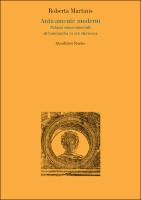Anticamente moderni
Palazzi rinascimentali di Lombardia in età sforzesca
| dc.contributor.author | Martinis, Roberta | |
| dc.date.accessioned | 2021-07-08T11:29:55Z | |
| dc.date.available | 2021-07-08T11:29:55Z | |
| dc.date.issued | 2021 | |
| dc.identifier | ONIX_20210708_9788822911636_143 | |
| dc.identifier | OCN: 1266286256 | |
| dc.identifier.uri | https://library.oapen.org/handle/20.500.12657/49953 | |
| dc.language | Italian | |
| dc.relation.ispartofseries | Quodlibet studio | |
| dc.subject.classification | thema EDItEUR::A The Arts::AM Architecture | en_US |
| dc.subject.other | Renaissance palaces | |
| dc.subject.other | Lombardy architecture | |
| dc.subject.other | Sforza | |
| dc.subject.other | Donato Bramante | |
| dc.subject.other | Agostino De Fondulis | |
| dc.title | Anticamente moderni | |
| dc.title.alternative | Palazzi rinascimentali di Lombardia in età sforzesca | |
| dc.type | book | |
| oapen.abstract.otherlanguage | The book examines the private palaces in the Duchy of Milan during the Sforza era, designed and built between Ludovico il Moro's seizure of power in 1480 and the first quarter of the following century. The result is a catalogue of examples that are essential for understanding the development of the typology and the emergence of a new housing model capable of including, among its functions, that of representing, by fixing it in a building, the social, political and cultural role of the client. Extensive chapters are devoted to the individual palazzi, which we can recognise - in the famous expression of Pietro Aretino - as "modernly ancient and antiquely modern". These chapters analyse them from various perspectives and lead to the identification of an innovative line in Lombard art, not only through examples in Milan, but also with precise verifications in Pavia, Piacenza, Lodi, Cremona, Crema and Vigevano, in parallel with what was happening in Florence or Venice, in Mantua or Ferrara and finally, at a slightly later date, in Rome. Through the analysis of the general advancement of architectural culture as a whole and of the interconnections between building sites, craftsmen and linguistic inventions, the range of architectures considered widens considerably to include some crucial religious buildings and, subsequently, several Roman palaces, where the descent of the "Lombards" - from Bramante from Urbino, by then integrated in Milanese cultural circles, to Bramantino and Cristoforo Solari - paved the way for decisive and critically inescapable exchanges. | |
| oapen.identifier.doi | 10.1400/281572 | |
| oapen.relation.isPublishedBy | 388783b6-7960-4780-a268-7c52996360f8 | |
| oapen.relation.isFundedBy | 07f61e34-5b96-49f0-9860-c87dd8228f26 | |
| oapen.relation.isbn | 9788822911636 | |
| oapen.collection | Swiss National Science Foundation (SNF) | |
| oapen.place.publication | Macerata - Italy | |
| oapen.grant.number | 10BP12_198599 | |
| oapen.grant.program | Open Access Books | |
| oapen.grant.project | "Anticamente moderni": palazzi rinascimentali di Lombardia in età sforzesca |

